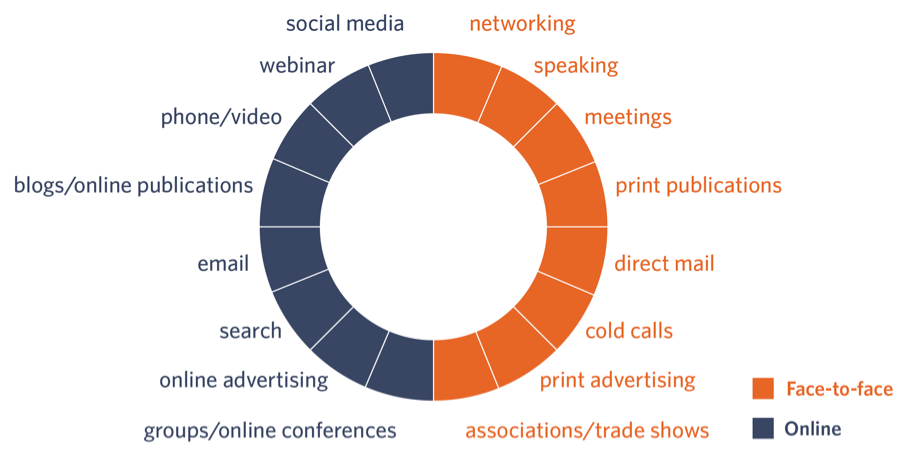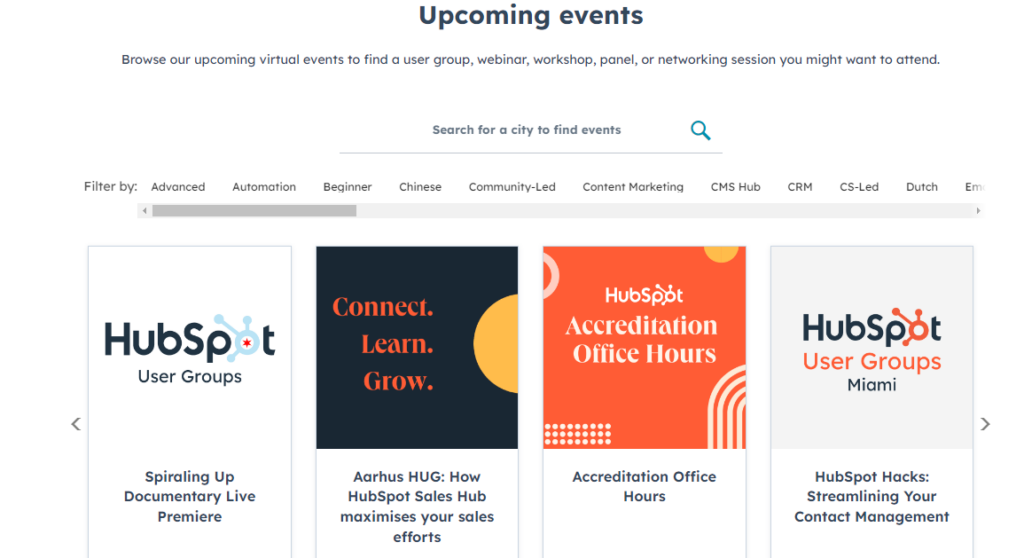The Complete Guide to Multichannel Lead Generation

Did you know that the average adult has more than 8 social media accounts? That the average American household has more than 10 connected devices? Or that it takes up to 13 touchpoints before a lead converts?
Companies must leverage many channels for lead generation and do it consistently over an extended period of time in order to see real results. This is why most organizations today have a multichannel lead generation strategy that streamlines their efforts into a focused plan.
In this article, we’ll cover the basics of multichannel lead generation and walk through the step-by-step process for building a strategy that’s effective for your organization.
Quick Takeaways
- Companies that use 4-6 channels earn the best response rates from customers.
- The best first step for building a multichannel lead generation strategy is to audit the channels you currently use, those your competitors use, and those you want to add.
- Your buyer personas play an important role in determining which channels you’ll use and prioritize in your strategy.
- Cross-promoting your channels keeps users engaged and helps drive more leads.
- Companies should set specific goals and evaluate them frequently to optimize results.
What is multichannel marketing?
To understand multichannel lead generation, you must understand its foundation: multichannel marketing.
Multichannel marketing strategies incorporate multiple promotion and distribution channels into a single unified strategy. It’s nothing new—companies have been using the multichannel approach for decades by aligning their TV, radio, and print advertising tactics. But today’s digital landscape has certainly transformed its requirements and ROI potential.
Now, companies have the ability to leverage traditional and digital channels to optimize their marketing efforts and reach customers in targeted and engaging ways.

Recent research shows that companies using 4-6 marketing channels receive the best response rates from customers. The thing to keep in mind is that the makeup of channels doesn’t look the same for every company.
While some are fairly standard (like email, for instance) the exact channels used (and their level of priority) will vary according to factors such as target audience, industry, and internal expertise and bandwidth.
How to implement a multichannel lead generation strategy
Know your channels
First and foremost, you need to know your channels—both those you already have in place and those you might want to add to your strategy.
We recommend conducting an audit of sorts, which you can do in three simple steps:
- List your current channels. What results are you already tracking? What ROI can you already see from these channels?
- Research the channels your top competitors are using. Are there any seemingly effective channels they’re using that you don’t?
- List the new channels you want or plan to incorporate into your strategy.
Taking these steps helps give you a full view of your current situation, identify competitive advantages and gaps, and clearly outline new tactics for the future.
Know your personas
Your buyer personas are critical to determining how to execute your multichannel lead generation strategy. Specifically, your personas determine which target audiences receive which messages and on which channels. This is because not all channels will be created equal for your buyer personas.
Let’s do a quick recap: Your buyer personas determine the different roles of buyers within your ideal B2B customer organization. Here’s a visual to help:
Because these people play different roles, they’ll likely prefer and prioritize different channels. A marketing professional, for example, might be better reached through search engines, communities, and an active presence on social media (particularly LinkedIn). Someone with a more technical and less visible role, like a software engineer, may be reached more easily by email, or on Reddit.
This is just one example. The takeaway is that you must know your buyer personas and research their behavior and preferences in order to reach them most effectively.
Set goals
What are you trying to accomplish with your multichannel lead generation strategy?
Of course you’re trying to generate more leads, but for this step you’ll want to dig a bit deeper.
Is there a specific target audience you’re looking to better engage? A certain channel you want to grow your presence on? Do you want to close leads at a higher rate? Your goals and objectives are the foundation of the strategy you’ll build.
It’s best to incorporate relevant teams (usually marketing and sales) into your goal setting process to gain important buy in. You should also work to make your goals data-driven and detailed so that you can accurately measure their success.
We recommend using the SMART goal framework, which helps you develop goals that are specific, measurable, attainable, relevant, and timely.
Create high-value content
Content marketing is a main driver of business growth across all of the channels you’re using. In some cases, like search engines, it’s an absolute necessity (you can’t appear in Google results if there is no content to rank) and in other cases it significantly increases your engagement (like on social media pages).
Original, high-value content helps you establish strong relationships with potential customers built on credibility and brand trust. Ultimately, content drives higher lead generation leads across channels by growing active engagement in comments sections, using lead magnets, earning email subscriptions and more.
Promote cross-traffic
Your channels should never operate in silos. You can keep customers engaged and grow more leads by cross-promoting your channels. This is an easy one! You can cross-promote by adding social media buttons to all of your blog posts and emails, sharing your blog posts on social media, mentioning your website address on radio ads or podcasts, including your most-read blog posts in your monthly newsletter — you get the idea.
When you cross-promote your channels, you show potential customers the true breadth of what you have to offer and give yourself more opportunities to convert new leads.
Measure results
Last but not least: don’t be complacent with your strategy. Good multichannel lead generation requires continual evaluation and pivoting to keep your strategy fresh and maximize ROI. It also keeps you and your teams accountable for executing your strategy according to plan.
If you set SMART goals, it won’t be difficult to take a data-driven approach to measuring your results.
It’s best to build evaluation directly into your plan — for example, list the metrics you’ll measure and the timing for doing it (i.e. monthly, weekly, or even daily). This way you can be sure it never falls through the cracks and you never miss an opportunity to improve.
Companies Excelling at Multichannel Lead Generation
Amazon
Amazon has become a ubiquitous brand name for most consumers, and it’s largely due to their effective multichannel lead generation. They have a massive online presence, and their listings usually appear at the top of the results page whenever a consumer searches for a specific product.
They effectively use SEO to optimize rankings, apps and targeted ads to reach users across social media channels, and are even expanding their brick-and-mortar presence with Amazon retail stores.
Collectively, these channels have worked seamlessly to position Amazon as the #1 general retailer in the minds of many consumers.
HubSpot
HubSpot has become a go-to resource for all things marketing and sales. Their blog is a massive online presence, but they’re also effective on other key digital marketing channels like social media, the online event circuit, email marketing and more. Their newsletters and webinars are popular with marketers in every industry.
Today, their event hub has expanded to include partner-hosted events around the world (see a snapshot below) and their newsletter now has a staggering 350,000 subscribers. These two marketing channels in particular are huge lead generators because users need to share contact information just to access them.

Moz
Moz is an SEO platform for inbound marketers that has created a hugely successful multichannel marketing trifecta: their blog, their YouTube channel, and their email newsletter.
Their Whiteboard Friday series (see the most recent episode below) is a fan favorite in the digital marketing space, and their blogs and newsletters are known for their sharp insights and expertise.
Moz uses other channels, too, like ads and social media, but their success is a great example of how finding the best-fit channels for your business makes a big impact.
Final Thoughts
Multichannel marketing is a must for companies that want to succeed winning new customers in crowded and competitive markets.
By following the steps we outlined in this guide, you can create a strategy rooted in your unique target audience’s behavior and preferences, while maximizing the strengths and capabilities of your brand. And if you’re looking for support, RevBoss is here to help.
Our outbound email software and lead generation services are custom-built for startups, consultancies, marketing agencies, and other B2B organizations.
Schedule a quick call with us and find out how we can help you win more clients.
